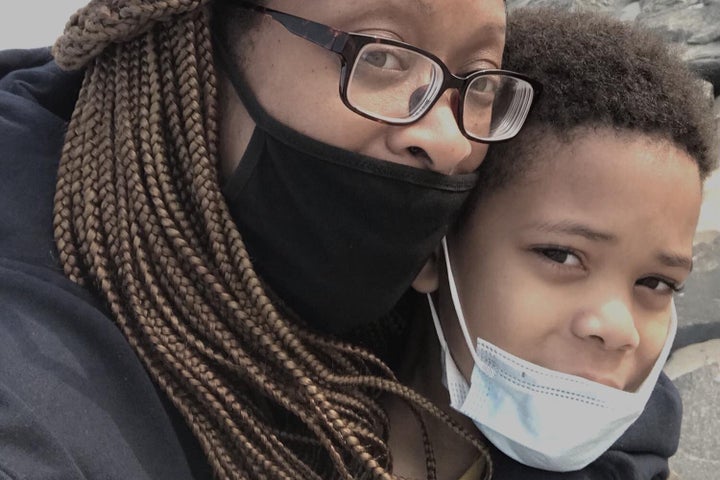
Tonya Hughes, a single mother in Rockville, Maryland, and a longtime substitute teacher, hasn’t worked since March 13, when her state first announced shutdowns because of the coronavirus.
Previously, she’d worked for 10 years as a substitute, making about $18 an hour. Now, like so many women around the country, Hughes is at home with her son, a second grader with a learning disability who needs help with virtual school.
The 48-year-old could go back to work, remotely, and teach over Zoom. But she can’t juggle supporting her son’s school day while running a classroom full of other kids at the same time, she said. “Do I take my son out of school so I can get my work done?” she asked, rhetorically.
Maybe she could get another job, outside the home after school, if she had child care. But Hughes is a single mother with no one to fall back on if she contracts COVID-19. “If I get sick, if anything happens to me, forget it. Who’s going to take care of my child?” she asked. For now, the two of them are at home — only leaving to take the bus to the grocery store or walk over to the school, which provides free grab n’ go lunches.
Faced with shaky job prospects across so many industries and often with children home for virtual school, many women have simply given up on the idea of working. All told, 2.1 million women have left the workforce since this pandemic started, compared to nearly 1.7 million men.
In December, as coronavirus cases surged in the U.S., that dynamic got worse, according to data released by the Labor Department last Friday. All of the 140,000 jobs lost in December were held by women, according to the new data. Meanwhile, American men gained 16,000 jobs that same month.
And though the pandemic has hurt all women, women of color are bearing the brunt of the pain. “The December job loss was definitely concentrated among Black and Hispanic women. No question,” said Heidi Shierholz, an economist and director of policy at the Economic Policy Institute. “For white women, it’s a total disaster, but that’s dwarfed by what’s happening in other demographic groups.”
“Do I take my son out of school so I can get my work done?”
- Tonya Hughes, 48
The unemployment rate for women overall, 6.3%, is twice as high as it was before the pandemic started. The unemployment rate is 8.45% for Black women and 9.1% for Latina women, according to Friday’s report.
In December, 154,000 Black women left the labor force entirely. That’s the largest drop in their employment since the beginning of the pandemic, the National Women’s Law Center pointed out in a data brief released Friday. Meanwhile, 200,000 white women actually returned to the workforce.
Women have been leaving the workforce throughout the pandemic, though. Most notably, in September, 863,000 were forced out. But at the time, the majority of those workers were white women.
Now it seems to be Black women’s turn. “What happened is concerning,” said Jasmine Tucker, director of research at the National Women’s Law Center. The reasons for the mass exodus aren’t necessarily as obvious as in September when back-to-school caused a seismic shift for working women, she said.
But there are a few things going on: Because of systemic racism, Black and Hispanic women are concentrated in different occupations than white women, Shierholz explained. And those occupations are the ones that got hit harder by shutdown measures — the restaurant industry, for example.
Those were the industries hit in December, she said, in a smaller-scale version of what the economy experienced last spring. An uptick in COVID-19 cases spurred job loss and an economic slowdown. In December, 500,000 jobs vanished in the leisure and hospitality sector alone.
Meanwhile, the pandemic has caused a huge uptick in unpaid work. Mothers are now homeschool teachers, just like Hughes. And with COVID-19 rates disproportionately higher for Black Americans, it stands to reason that the burden of caregiving also falls hardest on their shoulders.
Hoping For Christmas, Part 2

Without a steady income stream, Hughes has been getting by on a mix of resources, including federal food stamp benefits and a local food bank when things get really tight. In the spring, there were stimulus checks and beefed-up unemployment benefits. Those ran out long ago, however. Hughes, who is a member of the activist group Center for Popular Democracy, has been advocating for an extension for months.
The group has provided her with some support, too. It helps to have people she can just talk to right now, she said.
This past Christmas, Hughes wasn’t able to give her 8-year-old son any gifts under the tree. “I had to explain Santa was delayed because of COVID and the weather,” she said, explaining that it was rainy on Christmas Eve.
That was fine with him until he had to log back on for school and wasn’t sure what to tell his classmates about the holiday, she said.
Hughes did get a little bit of money from a member of her activist group, so she and her son took the bus to CVS to buy a few treats for themselves, like new gloves, a toy piano you can play with your feet and Santa hats for him and her 18-year-old daughter who lives nearby.
She is now waiting on another stimulus check. Congress authorized $300 payments at the end of the year, and Hughes is hoping she gets one soon. On Monday, Maryland’s governor announced an aid package that would provide stimulus payments of $750 for families.
Hughes was pretty excited. She plans on buying extra groceries and stuff for her house; the money would also mean she could Uber to doctor appointments instead of taking the bus.
And there would also be some cash for a Christmas 2, she said.
